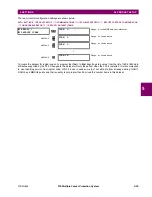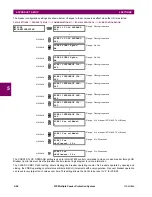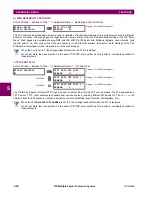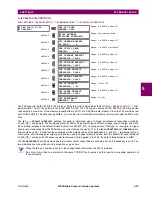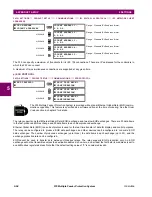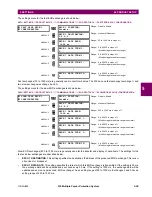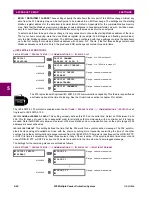
GE Multilin
F35 Multiple Feeder Protection System
5-67
5 SETTINGS
5.2 PRODUCT SETUP
5
The UR supports the Precision Time Protocol (PTP) specified in IEEE Std 1588 2008 using the Power Profile (PP) specified
in IEEE Std C37.238 2011. This enables the relay to synchronize to the international time standard over an Ethernet net-
work that implements PP.
The relay can be configured to operate on some PTP networks that are not strictly PP. Time accuracy can be less than
specified for a PP network. Tolerated deviations from strict PP include 1) missing declaration of PP compliance in the mes-
sages, 2) connection to a network device that does not support the PTP peer delay mechanism, 3) jitter substantially
greater than 1 µs in received event messages, and 4) certain non-compliant announce and sync message update rates.
The relay implements PTP according to IEEE Std 1588 2008 and the equivalent IEC 61588:2009(E), sometimes
referred to as version 2 PTP. It does not support the previous version of the standard (version 1).
PTP is a protocol that allows multiple clocks in a network to synchronize with one another. It permits synchronization accu-
racies better than 1 ns, but this requires each and every component in the network achieve very high levels of accuracy and
a very high baud rate, faster than normally used for relay communications. When operating over a generic Ethernet net-
work, time error may amount to 1 ms or more. PP is a profile of PTP which specifies a limited subset of PTP suitable for use
in power system protection, control, automation and data communication applications, and thereby facilitates interoperabil-
ity between different vendor’s clocks and switches. PP specifies a worst-case delivered time error of less than 1 µs over a
16-hop network.
In a PTP system and in a PP system, the clocks automatically organize themselves into a master-slave synchronization
hierarchy with the “best” clock available making itself the "grandmaster" at the top of the hierarchy; all others make them-
selves “slaves” and track the grandmaster. Typically the grandmaster clock receives its time from GPS satellites or some
other link to the international time standard. If the grandmaster fails, the next “best” clock available in the domain assumes
the grandmaster role. Should a clock on starting up discover it is “better” that the present grandmaster, it assumes the
grandmaster role and the previous grandmaster reverts to slave.
Time messages issued by the grandmaster are delayed as they pass through the network both due to the finite speed of
the signal in the interconnecting fiber or wire, and due to processing delays in the Ethernet switches. Each clock and switch
implementing PP measures the propagation delay to each of its PP neighbors, and compensates for these delays in the
time received. Each network device implementing PP measures the processing delay it introduces in each time message
and compensates for this delay in the time it transmits. As a result, the time delivered to end-devices such as the UR are
virtually identical to the grandmaster time. Should one of the network devices in the hierarchy not fully implement PP, the
associated propagation delay and/or latency may not be compensated for, and the time received at the end-device could be
in error by more than 100 µs.
See the
Settings > Product Setup > Real Time Clock
section of this manual for a description of when time values
received via PTP are used to update the relay’s real time clock.
The following settings are available for configuring the relay for PTP.
STRICT POWER PROFILE
•
Power profile (IEEE Std C37.238 2011) requires that the relay only select as a grandmaster power profile compliant
clocks, that the delivered time have worst-case error of ±1 µs, and that the peer delay mechanism be implemented.
With the strict power profile setting enabled, the relay will only select as master clocks displaying the IEEE_C37_238
identification codes. It will use a port only when the peer delay mechanism is operational. With the strict power profile
setting disabled, the relay will use clocks without the power profile identification when no power profile clocks are pres-
ent, and will use ports even if the peer delay mechanism is non-operational.
•
This setting applies to all of the relay’s PTP capable ports.
PTP DOMAIN NUMBER
•
This setting should be set to the domain number of the grandmaster-capable clock(s) to be synchronized to. A net-
work may support multiple time distribution domains, each distinguished with a unique domain number. More com-
monly, there is a single domain using the default domain number zero.
•
This setting applies to all of the relay’s PTP capable ports.
PTP VLAN PRIORITY
•
This setting selects the value of the priority field in the 802.1Q VLAN tag in request messages issued by the relay’s
peer delay mechanism. In compliance with PP the default VLAN priority is 4, but it is recommended that in accordance
with PTP it be set to 7.
NOTE
Summary of Contents for UR F35 Series
Page 10: ...x F35 Multiple Feeder Protection System GE Multilin TABLE OF CONTENTS ...
Page 366: ...5 238 F35 Multiple Feeder Protection System GE Multilin 5 10 TESTING 5 SETTINGS 5 ...
Page 426: ...10 12 F35 Multiple Feeder Protection System GE Multilin 10 6 DISPOSAL 10 MAINTENANCE 10 ...
Page 454: ...A 28 F35 Multiple Feeder Protection System GE Multilin A 1 PARAMETER LISTS APPENDIX A A ...
Page 620: ...F 12 F35 Multiple Feeder Protection System GE Multilin F 2 DNP POINT LISTS APPENDIX F F ...
Page 630: ...H 8 F35 Multiple Feeder Protection System GE Multilin H 3 WARRANTY APPENDIX H H ...
Page 640: ...x F35 Multiple Feeder Protection System GE Multilin INDEX ...

